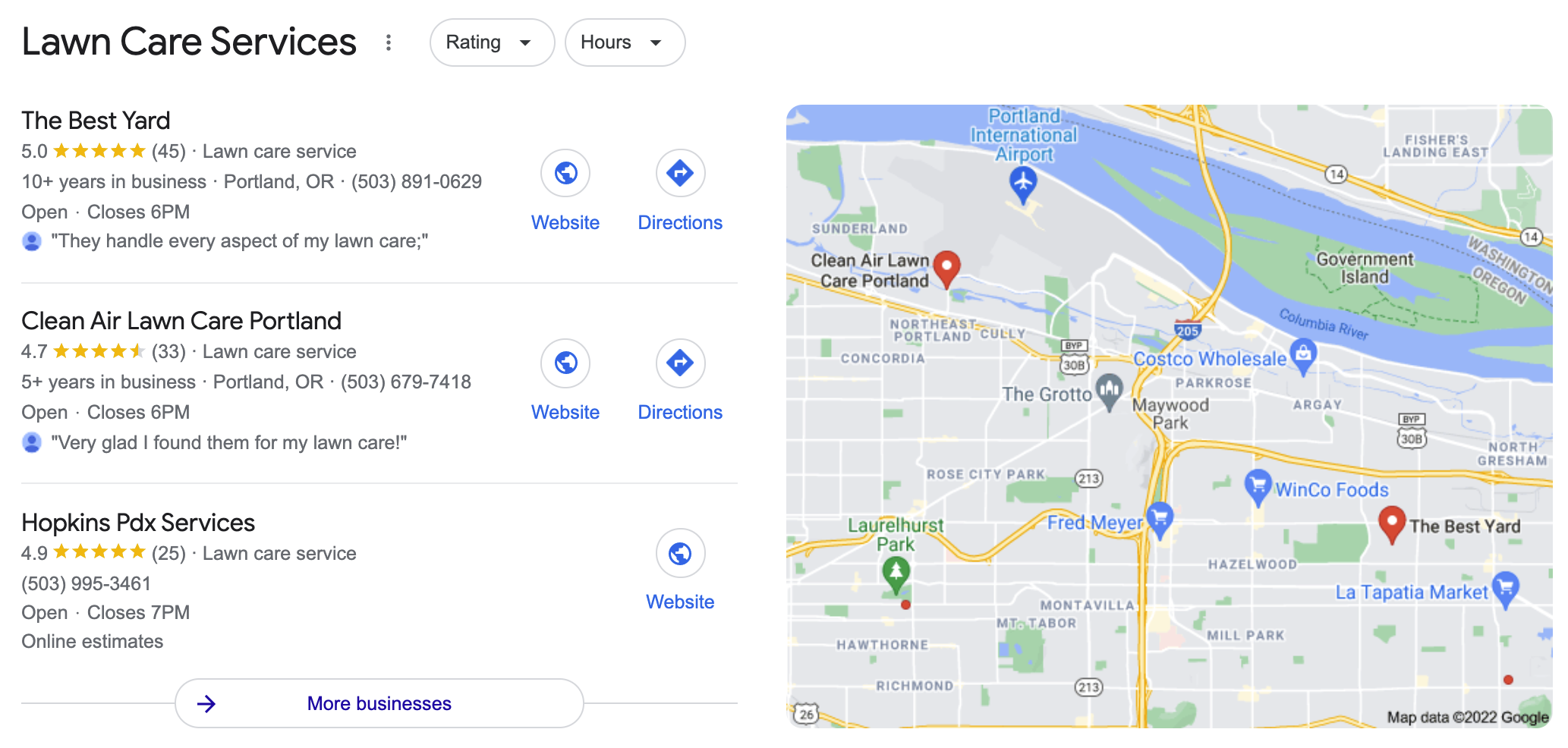SEO for Local Businesses
Why should you care about local search?
In short, because "everybody's doing it."
Searches including the phrase near me have had a meteoric rise over the last 5-7 years -- interrupted only for a month or two during the initial wave of the COVID-19 pandemic.
And that's only a fraction of local searches.
How many local searches are there?
While they've become increasingly tight-lipped in recent years, historically, Google has said:
- 20% of all desktop queries demonstrate local intent
- 50% of all queries are mobile
- 50% of all mobile queries demonstrate local intent
That's hundreds of billions of consumer searches every year!
(There's a key term in those statistics: local intent. I'll discuss more about this below in "What is a local search?")
Purchase Intent
Local searchers are also targeted searchers -- not only do they know what product or service they're looking for, but they're looking for it in a particular area. And if they're searching on their mobile device, there's an immediacy factor which makes their chances of converting to a customer increase even further.
What is a local search?
This sounds like a stupid question, but the answer isn't quite as obvious as it would seem.
A local search is any search for which Google infers the searcher is interested location-relevant results, based on its analysis of trillions of historical searches.
Not every local search needs to contain a geographic keyword or a near-me modifier.
Based on the term a searcher types, and Google's inference of their location, Google will localize results for selected product & service-based searches without any geographic modifiers where they detect that a searcher has strong intent to purchase that product or service locally.
Keywords and phrases like restaurants, orthopedic surgeons, and lawn care services are examples of local-intent keywords whose results are heavily localized without an explicit geographic term (like Pizza in Portland, OR).
What does Google return for local searches?
Ads, Business Profiles (Local Pack Results), and Webpages (Organic Results)
Most local intent searches at Google return three distinct result types, which almost always appear in the same order on the page. Ads are at the top, followed by Local results featuring Google Business Profiles, followed by organic results featuring links to webpages.
Each of these three result types is driven by a unique algorithm, meaning:
There are a lot of things to consider when you're trying to optimize your presence on Google!
There are multiple ways to show up on Google for the same keyword.
The most successful companies have a comprehensive strategy that optimizes for each of these three algorithms.
Ads
It's hard to find a search result these days that doesn't start with ads at the top of the page.
While Google seems to introduce a new ad unit every six months, as of 2022, the three main ad types that show up most commonly for locally-oriented searches are traditional text ads, product listing ads and local inventory ads, and local service ads.
Traditional text ads
Over time, these ads have become less and less distinguishable from organic results. But a tiny Ad icon seems enough to satisfy the Federal Trade Commission, at least for now.
When Google Ads' predecessor Adwords was first released, it was a pure auction model: the higher an advertiser bid for a certain keyword, the higher in the list their ad appeared. Over time, Google has introduced a number of other factors as it's tried to improve the searcher experience (and increase the dollars flowing to its bank account).
Product Listing Ads (PLAs) and Local Inventory Ads (LIAs)
Where they appear, the images that accompany Product Listing Ads are some of the most eye-catching features of any local search result. In order to qualify for these ads you must have a Google Merchant Center account, which is a free portal to distribute your products on Google Shopping.
Once approved, you can then submit your Merchant Center feed via Google Ads to generate these Product Listing Ads and set your preferred bid amount for each.
And if you link your Google Business Profile (see more below), you'll enable Local Inventory Ads, which unlock the the "pick up today" badge on each of your products -- a key visual differentiator in a world driven by instant gratification.
Local Service Ads (LSAs)
Local Service Ads are the visual equivalent of Product Listing Ads for companies that sell services instead of products.
They're only available in certain industries and in certain markets but anecdotally they've been very popular with local businesses. Unlike traditional text ads and Local Inventory Ads where advertisers pay per click, local service ads allow a business to pay a fixed amount per lead. Google directs each searcher to request a quote or provides a trackable phone number to facilitate this pricing model.
Not every business will be eligible for Local Service Ads -- Google runs each applicant through a rigorous screening process, which in some industries includes background checks of every employee who might interact with a customer during a service call.
While Local Service Ads appear to contain elements of a Google Business Profile (see more below) they operate independently.
Tom Waddington is THE expert on LSAs and I highly recommend reading this guide if you'd like to learn more.
Ad takeaways
The important takeaways here are that:
Paying Google is the only way to guarantee premium positioning for any given keyword -- and sometimes even paying Google isn't enough to guarantee that.
Depending on what you sell, a different type of ad unit (e.g. PLAs or LSAs) may bring in more customers than traditional text ads.
Google will continue to show more and more ads for more and more search terms.
Business Profiles (Local Pack Results)
Since January 2008 Google has displayed a separate interface at the top of most results for. local intent keywords and keyphrases. Today, this interface typically features a map and a combination of three business listings. This interface is known colloquially in the search marketing industry as a "Local Pack." (As an aside, many Local Pack results also contain one ad at the top.)
Unlike ads and organic results, the results in these Packs link primarily to Google Business Profiles, where searchers can see opening hours, browse photos, read reviews, view special offers, get directions, call you, and even get a quote or place an order directly from your Business Profile.
In order to be eligible for these results, a business must operate from a physical location (not a P.O. Box) and either serve customers at that location or within some defined radius around it. (Service-area businesses may choose to hide their physical address.)
The algorithm that drives Local Pack results relies partly on the strength of your website, but that's only a relatively small piece of the puzzle. Far more important are your review profile, category choices, photo quality and volume, and — a big factor you can't control — how close your business is located to the searcher.
Webpages (Organic Results)
The third set of results for a typical local search is actually the set that made Google the world's dominant search engine in the mid-2000's.
This section is still sometimes referred to as the "10 blue links" portion of the search result, but as you can see from the screenshot at the right, it's not just links. There are also questions, images, and in some cases video and news results are blended into the organic results as well.
Generally speaking these results are more competitive than Local Pack results, as they're open to any business, not just those with physical locations. So blogs, directories, and global brands (with much larger marketing budgets and more expertise than a typical local business) frequently outrank smaller players.
Generally speaking, the more words in a keyphrase, the better the chance your website will have at ranking in these organic results, assuming it's well-optimized.
How can Local SEO help your business?
Local search engine optimization (Local SEO) combines a number of techniques that make your website and your Google Business Profile as easy as possible for search engines to find and filter, and seek to increase its authority relative to other businesses.
Google and a number of other search engines publish suggestions that will help give your site higher rankings, but typically it takes an experienced consultant to propel your site into the top handful of results, where the overwhelming majority of all clicks come from. Search Engine Optimization involves a relatively high initial investment but can reap an enormous number of "free" clicks if done well.
For a deeper dives into how to rank your business in Local Pack and Organic results, I recommend the following resources:
SEO Cheatsheet for Small Businesses
An easily digestible plan of attack for small businesses without an in-house marketer.
Reviews and Local SEO
A detailed look at how Google evaluates reviews and why they're so essential to your local search success.
The Local Search Ranking Factors
I began this now-annual survey of 30-40 of the top Local SEO practitioners in the world in 2008, and handed it off to Darren Shaw of Whitespark in 2016. It remains perhaps the best summary of tactices that are (and are not) working in local search.






